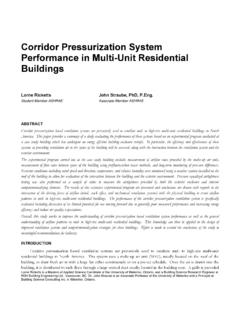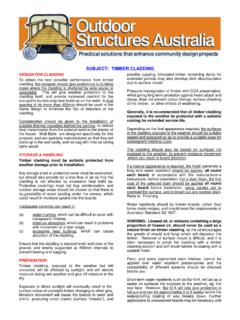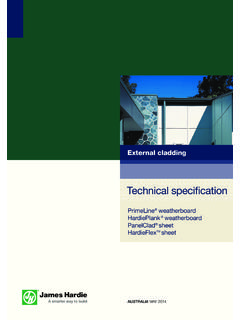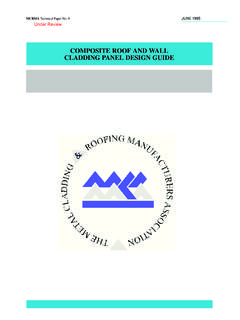Transcription of No. 011 Cladding Attachment Solutions for Exterior ...
1 December 2015 1 Cladding Attachment Solutions for Exterior insulated Commercial Walls By Graham Finch, , MASc, & James Higgins, No. 011 TB-011 Cladding Attachment Solutions for Exterior insulated Commercial Walls December 2015 2 Introduction The use of Exterior insulation installed outboard of wall sheathing is becoming increasingly common across North America to meet new energy code requirements. Commonly referred to as Exterior insulation, this insulation is installed continuously on the outside of the primary structure and is typically more thermally efficient than insulation placed between studs or inboard of the structural system, provided that thermally efficient Cladding attachments are used. Exterior insulation also has significant benefits for durability and thermal comfort as well.
2 As a result, greater attention is being paid to the design of thermally efficient structural Attachment systems, and several proprietary systems have been introduced into the market in recent years to meet this demand. Cladding Attachment options include continuous girts, intermittent clip & rail systems, long screws, masonry ties, and other engineered supports. The challenge designers and contractors face is selecting and evaluating an appropriate Cladding Attachment strategy for their project and understanding the implications these decisions have on effective thermal performance, installation methods, sequencing, and system costs. The thermal infrared image on the left shows a stucco Cladding with thermally inefficient continuous vertical Z-girt Cladding support system to left side of wall versus thermally efficient low-conductivity clip and rail Cladding support system to right side.
3 The insulation within the continuous girts is less than 25% effective, whereas the insulation between the intermittent clips is over 80% effective significantly improving the thermal performance of the wall for the same construction cost. This bulletin clarifies and provides guidance regarding different Cladding Attachment systems through Exterior insulation for commercial wall applications. Exterior insulated Split insulated Interior insulated Figure 1: Standard approaches to insulating steel-framed wall assemblies Figure 2: Thermal infrared image of two different Cladding support systems, to the left - continuous vertical steel Z-girts, and the to the right - intermittent low-conductivity clips. TB-011 Cladding Attachment Solutions for Exterior insulated Commercial Walls December 2015 3 Energy Codes & Exterior Insulation There are various different energy codes and standards in force across North America for commercial buildings.
4 The two most widely applicable energy codes are the International Energy Conservation Code (IECC) in the United States, and the National Energy Code for Buildings (NECB) in Canada. The most commonly referenced energy standard is ASHRAE Standard , which is referenced by building and energy codes in the majority of American States and by some Canadian Provinces. Different versions and adaptations of these standards and codes are in effect in the Provinces and States. While different versions and adaptations of these regulations are enforced in different jurisdictions, each requires consideration for thermal bridging and effectiveness of installed insulation. Exterior insulation presents an efficient and cost-effective method to provide improved thermal performance and meet the requirements of these regulations; however, the effectiveness of this approach hinges on the selection of a thermally efficient Cladding Attachment strategy.
5 The Cladding Attachment can be a significant thermal bridge and reduce Exterior insulation performance by as little as 5-10% for high-performance systems, and as much as 80% for poor systems. Requirements for Cladding Attachment There are several considerations which must be made with respect to choosing a type of Exterior insulation and Cladding Attachment strategy for a building. These typically include at a minimum: Cladding weight and gravity loads Wind Loads Seismic Loads Back-up wall construction (wood, concrete, concrete block, or steel framing etc.) Attachment point back into the structure (through studs, sheathing, or slab edge) Thickness of Exterior insulation Use of rigid, semi-rigid or spray-applied insulation Ability to fasten Cladding supports directly through the face of rigid insulation boards Ability to fit semi-rigid or sprayed insulation tightly around discrete supports and ease of installation Effective R-value target and tolerable thermal efficiency loss from supports Orientation and required Attachment location for Cladding system (panel, vertical, horizontal) Details for Attachment of Cladding at corners, returns and penetrations.
6 Combustibility requirements Accommodation of dimensional tolerance Allowable wall thickness TB-011 Cladding Attachment Solutions for Exterior insulated Commercial Walls December 2015 4 The design of the Cladding Attachment system will typically be performed by a structural or fa ade engineer working for the architect or Cladding manufacturer. Many Cladding support systems have been pre-engineered and designed using load tables developed by the manufacturer. It is important that the Cladding support designer understands the requirements of the project including the thermal requirement so that the system and spacing of supports can be optimized to make the best use of the Exterior insulation. Various options exist, and will be selected based on a number of factors as discussed here.
7 Discrete clip and rail type Cladding support with rigid insulation placed between clip supports inboard of the continuous vertical rail. Cladding attached back to vertical rails on Exterior of insulation. Long screws through rigid insulation utilizing continuous vertical strapping to create a truss Cladding support system. Cladding attached to strapping on Exterior of insulation. Masonry ties with semi-rigid insulation. The tie supports here provide only lateral resistance support, not gravity load (supported at the base of the veneer). Figure 3: Examples of various Cladding Attachment stategies through Exterior insulation Cladding Attachment Systems There are numerous generic and proprietary Cladding support systems designed for use with Exterior insulation available on the market today, and many different materials are used to make these systems including galvanized steel, stainless steel, aluminum, fiberglass, composites and plastic.
8 While each system is different, the approaches can generally be classified as: continuous framing, intermittent clip and rail, long fasteners and masonry or other engineered systems. Systems are available to accommodate a wide range of claddings for buildings of all heights and exposures. Typically the heavier the Cladding or extreme the wind load the tighter the spacing of the supports at compromise to the effective thermal performance. The best system is one that is optimized structurally and thermally for the Cladding support needs of the specific project. An overview of several different Cladding support systems are provided in the sections below. For each of the systems a relative cost ($ - $$$), thermal efficiency ( percent effectiveness of the Exterior insulation), and ease of installation ranking is provided.
9 Within all of the systems, Exterior insulation is typically appropriate except where noted. All of the Cladding systems can be installed with wood, steel stud, or concrete/concrete block back-up walls, with most systems lending themselves better to commercial construction rather than residential practices. TB-011 Cladding Attachment Solutions for Exterior insulated Commercial Walls December 2015 5 Continuous Framing Continuous girt Cladding support systems are the predecessors to the more thermally efficient clip and rail systems that have been developed in the past few years. While continuous framing systems do not perform nearly as well thermally, they still used in some applications. Continuous Framing - Vertical Z-Girts Relative Cost $$$ Thermal Efficiency 20-40% Constructability This Cladding Attachment consists of continuous galvanized steel framing members, typically 18 to 20 gauge Z-girt or C-channel profiles attached vertically to the back-up wall.
10 Typically girts are spaced to line up with stud framing behind (every 16 to 24 ). Cladding systems are attached directly to the outer flange of the z-girts. Where vertically oriented Cladding is used, additional horizontal sub-girts may be applied to the Exterior of the verticals. Vertical Z-girts are not a thermally efficient Cladding system and are not recommended in typical applications due to the excessive amount of thermal bridging. Exterior insulation installed between vertical Z-girts is degraded significantly and is only 20-40% effective for typical applications. While thermal breaks at the sheathing level can be beneficial, the insulation is still largely bridged, making the improvement mostly to surface temperature rather than U-value. In terms of prescriptive code compliance, it is very difficult to meet effective R-value requirements with this system.








